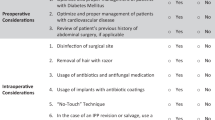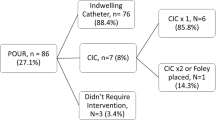Abstract
Defining the risks associated with diabetes mellitus in patients undergoing penile prosthesis implantation remains controversial. Our study aims to assess whether preoperative hemoglobin a1c and preoperative blood glucose levels are associated with an increased risk for postoperative infection in diabetic men. We performed a retrospective review of 932 diabetic patients undergoing primary penile prosthesis implantation from 18 high-volume penile prosthesis implantation surgeons throughout the United States, Germany, Belgium, and South Korea. Preoperative hemoglobin a1c and blood glucose levels within 6 h of surgery were collected and assessed in univariate and multivariate models for correlation with postoperative infection, revision, and explantation rates. The primary outcome is postoperative infection and the secondary outcomes are postoperative revision and explantation. In all, 875 patients were included in the final analysis. There were no associations between preoperative blood glucose levels or hemoglobin a1c levels and postoperative infection rates; p = 0.220 and p = 0.598, respectively. On multivariate analysis, a history of diabetes-related complications was a significant predictor of higher revision rates (p = 0.034), but was nonsignificant for infection or explantation rates. We conclude preoperative blood glucose levels and hemoglobin a1c levels are not associated with an increased risk for postoperative infection, revision, or explantation in diabetic men undergoing penile prosthesis implantation.
This is a preview of subscription content, access via your institution
Access options
Subscribe to this journal
Receive 8 print issues and online access
$259.00 per year
only $32.38 per issue
Buy this article
- Purchase on Springer Link
- Instant access to full article PDF
Prices may be subject to local taxes which are calculated during checkout
Similar content being viewed by others
References
Burnett AL, Nehra A, Breau RH, Culkin DJ, Faraday MM, Hakim LS, et al. Erectile dysfunction: AUA guideline. J Urol. 2018;200:633–41. https://doi.org/10.1016/j.juro.2018.05.004.
Levine LA, Becher EF, Bella AJ, Brant WO, Kohler TS, Martinez-Salamanca JI, et al. Penile prosthesis surgery: current recommendations from the international consultation on sexual medicine. J Sex Med. 2016;13:489–518. https://doi.org/10.1016/j.jsxm.2016.01.017.
Huynh LM, Osman MM, Yafi FA. Risk profiling in patients undergoing penile prosthesis implantation. Asian J Androl. 2019. https://doi.org/10.4103/aja.aja_92_19.
Narang GL, Figler BD, Coward RM. Preoperative counseling and expectation management for inflatable penile prosthesis implantation. Transl Androl Urol. 2017;6:S869–80. https://doi.org/10.21037/tau.2017.07.04.
Lipsky MJ, Onyeji I, Golan R, Munarriz R, Kashanian JA, Stember DS, et al. Diabetes is a risk factor for inflatable penile prosthesis infection: analysis of a large statewide database. Sex Med. 2019;7:35–40. https://doi.org/10.1016/j.esxm.2018.11.007.
Bishop JR, Moul JW, Sihelnik SA, Peppas DS, Gormley TS, McLeod DG. Use of glycosylated hemoglobin to identify diabetics at high risk for penile periprosthetic infections. J Urol. 1992;147:386–8. https://doi.org/10.1016/s0022-5347(17)37244-0.
Habous M, Tal R, Tealab A, Soliman T, Nassar M, Mekawi Z, et al. Defining a glycated haemoglobin (HbA1c) level that predicts increased risk of penile implant infection. BJU Int. 2018;121:293–300. https://doi.org/10.1111/bju.14076.
Wilson SK, Carson CC, Cleves MA, Delk JR 2nd. Quantifying risk of penile prosthesis infection with elevated glycosylated hemoglobin. J Urol. 1998;159:1537–9. https://doi.org/10.1097/00005392-199805000-00034.
Canguven O, Talib R, El Ansari W, Khalafalla K, Al Ansari A. Is Hba1c level of diabetic patients associated with penile prosthesis implantation infections? Aging Male. 2018;9:1–6. https://doi.org/10.1080/13685538.2018.1448059.
Ogurtsova K, da Rocha Fernandes JD, Huang Y, Linnenkamp U, Guariguata L, Cho NH, et al. IDF diabetes atlas: global estimates for the prevalence of diabetes for 2015 and 2040. Diabetes Res Clin Pr. 2017;128:40–50. https://doi.org/10.1016/j.diabres.2017.03.024.
Okonkwo UA, DiPietro LA. Diabetes and wound angiogenesis. Int J Mol Sci. 2017;18:E1419. https://doi.org/10.3390/ijms18071419.
Wang R, Panizales MT, Hudson MS, Rogers SO, Schnipper JL. Preoperative glucose as a screening tool in patients without diabetes. J Surg Res. 2014;186:371–8. https://doi.org/10.1016/j.jss.2013.09.014.
Davis MC, Ziewacz JE, Sullivan SE, El-Sayed AM. Preoperative hyperglycemia and complication risk following neurosurgical intervention: a study of 918 consecutive cases. Surg Neurol Int. 2012;3:49. https://doi.org/10.4103/2152-7806.96071.
Shalaurova I, Connelly MA, Garvey WT, Otvos JD. Lipoprotein insulin resistance index: a lipoprotein particle-derived measure of insulin resistance. Metab Syndr Relat Disord. 2014;12:422–9. https://doi.org/10.1089/met.2014.0050.
Harada PHN, Demler OV, Dugani SB, Akinkuolie AO, Moorthy MV, Ridker PM, et al. Lipoprotein insulin resistance score and risk of incident diabetes during extended follow-up of 20 years: the Women’s Health Study. J Clin Lipido. 2017;11:1257–67.e2. https://doi.org/10.1016/j.jacl.2017.06.008.
Author information
Authors and Affiliations
Corresponding author
Ethics declarations
Conflict of interest
FAY reports associations with Endo Pharmaceuticals as consultant and speaker; Antares Pharma as consultant and speaker; Coloplast as speaker and advisory board; and Viome as clinical trial primary investigator. All other authors declare that they have no conflict of interest.
Additional information
Publisher’s note Springer Nature remains neutral with regard to jurisdictional claims in published maps and institutional affiliations.
Rights and permissions
About this article
Cite this article
Osman, M.M., Huynh, L.M., El-Khatib, F.M. et al. Immediate preoperative blood glucose and hemoglobin a1c levels are not predictive of postoperative infections in diabetic men undergoing penile prosthesis placement. Int J Impot Res 33, 296–302 (2021). https://doi.org/10.1038/s41443-020-0261-5
Received:
Revised:
Accepted:
Published:
Issue Date:
DOI: https://doi.org/10.1038/s41443-020-0261-5
This article is cited by
-
Maximizing outcomes in penile prosthetic surgery: exploring strategies to prevent and manage infectious and non-infectious complications
International Journal of Impotence Research (2023)
-
Risk of unfavorable outcomes after penile prosthesis implantation – results from a national registry (INSIST-ED)
International Journal of Impotence Research (2023)
-
The International Penile Prosthesis Implant Consensus Forum: clinical recommendations and surgical principles on the inflatable 3-piece penile prosthesis implant
Nature Reviews Urology (2022)
-
Correlation of fasting blood sugar at the time of penile prosthesis surgery with the level of glycated hemoglobin and the outcome of surgery
African Journal of Urology (2021)
-
Penile implant infection prevention part 1: what is fact and what is fiction? Wilson’s Workshop #9
International Journal of Impotence Research (2021)



